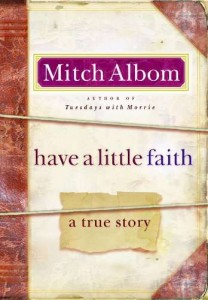 It is not often that I get teary at the end of a book, but Mitch Albom has done it again in his book have a little faith: a true story (Albom, Mitch, 2011). It really made me mad, because I was finishing it in a restaurant while waiting for my food. I hate it when that happens. Albom is also the author of Tuesdays With Morrie, and this book continues his tradition of getting to the heart of the person.
It is not often that I get teary at the end of a book, but Mitch Albom has done it again in his book have a little faith: a true story (Albom, Mitch, 2011). It really made me mad, because I was finishing it in a restaurant while waiting for my food. I hate it when that happens. Albom is also the author of Tuesdays With Morrie, and this book continues his tradition of getting to the heart of the person.
Anyway, this is a profound exploration of the lives of two men of faith and recounts the pivot points (my descriptor, not Albom’s) that shaped and formed their lives of faith. One is a pentecostal preacher, operating an inner city homeless shelter, and the other is a rabbi of a large synagogue. Each gives a picture of how faith informs life and life informs faith. Albom, himself, confesses that the process of writing the book impacted his faith.
The rabbi, called Reb, is the faith leader who shaped and formed Albom his entire life. Reb was initially turned down from the rabbinical seminary, but was led back by someone who offered him a challenge. Reb graduates and then goes to a small faith community, meeting in a simple house. After 60 years, he has stayed in the same place but has, through caring leadership, expanded the ministry to become a large faith community. Reb asks Albom to offer the eulogy at his funeral, and for the next years, Albom spends time interviewing Reb in order to know him deeply. What happens is a deepening of relationship and an understanding as to how life events shape us. The eulogy is well worth waiting for and provides incredible insight into life.
The pentecostal preacher started life as a drug dealer and thief and through a series of events was drawn to the faith and then was drawn to serving the social needs of the inner city population. His story is NOT predictable and, particularly the ending, is not what I expected.
Each man, including Albom, discovers how pivot points in life impact and shape us. If I were writing a study guide for this book (which I am thinking about doing) I would have to ask the reader to identify the turning points and influential people in their own lives. Becoming aware of these shaping events and reflecting upon them, deepens the journey and offers a richness that otherwise can be missed.
For those who get worried about these things, the book would not probably pass the doctrinal review process of certain denominations. One has to let the author define the term “faith” and how it is expressed. Rather than be concerned about the correct faith language, I would suggest that one listen to the story and ask the question, “Where is God present in this story?” To wrestle with that question may lead another reader to tears at the end.



